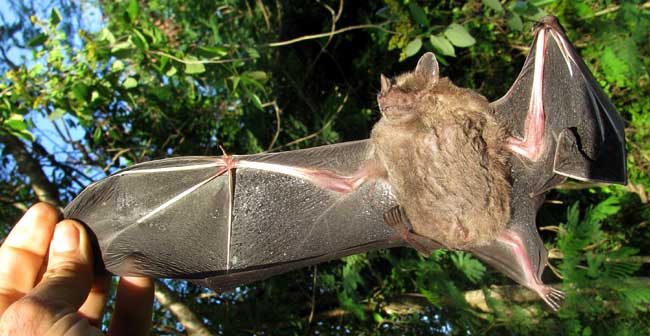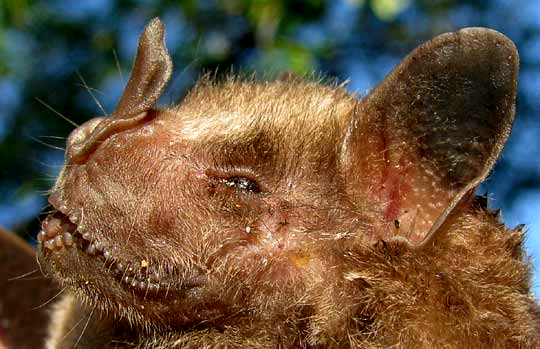Excerpts from Jim Conrad's
Naturalist Newsletter

from the December 6, 2009 Newsletter issued from Hacienda Chichen Resort beside Chichén Itzá Ruins, central Yucatán, MÉXICO; limestone bedrock, elevation ~39m (~128ft), ~N20.676°, ~W88.569°
FRUIT BAT
Walking to Pisté for my weekly supply of oranges and bananas I came upon a furry, brown, crumpled heap at the pavement's edge. It didn't move when I nudged it so I flipped it over. It was a dead, good-sized bat. I like bats a lot and was real sorry to see this. I picked him up and took the picture (turned on its side to fit the computer screen, so "up" is at the left) above.
He was a lot larger than most species I run into, but the most unusual feature about him was the appendage arising from the tip of his snout. A close-up is below:

From matching our pictures with images on the Internet, I'm guessing that this is the Jamaican Fruit Bat, ARTIBEUS JAMAICENSIS...
*UPDATE: In 2014, with many more identification resources on the Interent, I upload our pictures to iNaturalist, where user "the_mexican_violetear," a PhD candidate at UNAM, Mexico's main university, recognized the Great Fruit-eating Bat, ARTIBEUS LITURATUS. Still, just from the pictures, I could see no consistent differences between Artibeus jamaicensis and A. lituratus -- and both species commonly occur in the northern Yucatan -- so I asked "the_mexican_violetear" how he determined the identification.
He replied that from his extensive field experience with the two species he knew that A. jamaicensis tends to be grayish with lightly marked faces, while A. lituratus is more of a chocolate or maroon color, and facial markings are very conspicuous -- though these features sometimes occur in both species. Also, A. jamaicensis occurs almost exclusively in caves, while A. lituratus prefers vegetation and human buildings. However, the best distinction is the forearm measurement. For my observation, the bat's occurrence in a very active tourist zone appears and its rich chocolate color together seem adequate for indicating A. literatus.
The Great Fruit-eating Bat occurs throughout Mexico south through through most of South America to southern Brazil. The AnimalDiversity.Org website Artibeus literatus page tells us that the species lives in "harems" comprising a single male and two to five females, but sometimes can attain up to 20 members. Typically they roost in trees during the day, and feed in fruit trees at night. On nights with full moons, feeding decreases, supposedly to avoid being spotted by predators like owls.
As such, the species disperses fruit seeds in their feces, enabling fruit-producing plants to spread their offspring over a large area.
When I tossed the dead bat into the weeds, I stood a moment and conjured in my mind the image of a healthy bat busy with important chores, flying deeply into the night, into a vast and embracing fragrance of sweet, juicy fruit. If it turns out that there are something like souls and heavens, then maybe my visualization somehow helped the little being on its final journey.